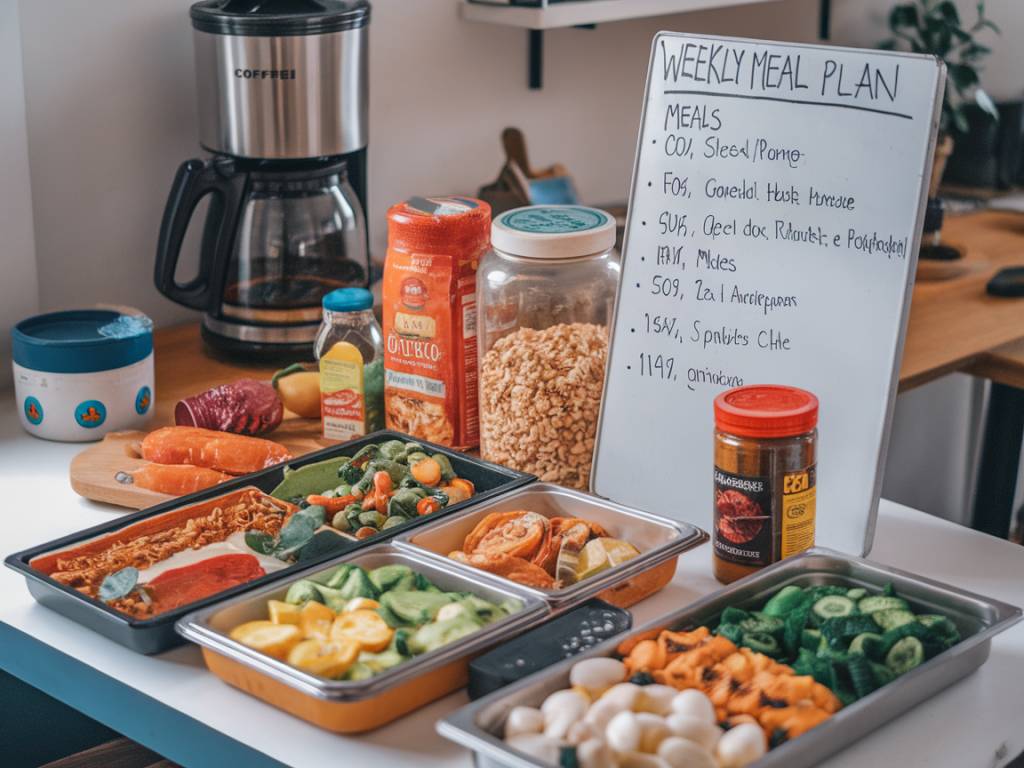Are you looking to streamline your weekly meal prep to save both time and money? Creating a well-organized meal prep plan can significantly reduce the stress of daily cooking, minimize food waste, and help you avoid last-minute takeout orders. This detailed guide will walk you through the essential steps to craft an effective and efficient weekly meal prep plan.
Why Meal Prep?
Meal prepping offers numerous benefits that can transform your daily routine. Some of the key advantages include:
- Saving Time: By dedicating a few hours each week to meal prep, you can avoid the daily grind of cooking from scratch.
- Saving Money: Buying ingredients in bulk and reducing food waste can significantly cut down your grocery bills.
- Promoting Healthy Eating: Having pre-prepared meals makes it easier to stick to nutritious eating habits.
- Reducing Stress: Knowing what you’ll be eating each day eliminates the stress of meal decision-making.
Step 1: Set Your Goals
Before diving into meal prep, it’s essential to set clear goals. What do you aim to achieve with your meal prep plan? Common goals include:
- Weight Loss or Maintenance: Preparing portion-controlled, balanced meals.
- Time Savings: Minimizing daily cooking and clean-up.
- Budget Management: Reducing grocery bills and cutting back on dining out.
- Dietary Needs: Adhering to specific dietary restrictions or preferences.
Having a clear understanding of your objectives will guide your meal prep process and ensure it aligns with your lifestyle.
Step 2: Choose Your Meals
Selecting the right meals is crucial for a successful meal prep plan. Here are some tips to consider:
- Balanced Nutrition: Aim for meals that incorporate proteins, carbohydrates, and healthy fats.
- Variety: Avoid monotony by selecting a variety of dishes and alternating ingredients each week.
- Storage-friendly: Choose meals that keep well in the fridge or freezer and reheat nicely.
For example, you might opt for grilled chicken with quinoa and vegetables, a hearty chickpea salad, or a batch of homemade soup.
Step 3: Plan Your Menu
Once you’ve chosen your meals, it’s time to plan your menu. Creating a detailed menu for the week will streamline your grocery shopping and prep work. Here’s how to do it:
- List Your Meals: Write down all the meals you’ll prepare for the week, including breakfasts, lunches, dinners, and snacks.
- Review Recipes: Go through the recipes and note down the ingredients you need for each dish.
- Group Similar Ingredients: To simplify your shopping and prep, group your ingredients by category (e.g., vegetables, proteins, grains).
A well-thought-out menu will make the rest of the meal prep process much more manageable.
Step 4: Create a Shopping List
With your menu in hand, it’s time to create a shopping list. A detailed list ensures you buy exactly what you need, reducing impulse purchases and food waste. Follow these steps:
- Categorize Items: Organize your shopping list by categories such as produce, dairy, meat, and pantry staples.
- Check Inventory: Review what you already have at home to avoid buying duplicates.
- Stick to the List: Try to adhere strictly to your list to avoid unnecessary spending.
Step 5: Prep Your Ingredients
Once you have your groceries, it’s time to start prepping your ingredients. This step can be divided into two main tasks: washing and chopping.
- Washing: Thoroughly wash all fruits and vegetables. Consider using a veggie wash or a vinegar solution to eliminate any pesticides and bacteria.
- Chopping: Cut your vegetables, fruits, and proteins as required by your recipes. Store them in labeled, air-tight containers to keep them fresh.
This preliminary prep work will save you a significant amount of time during the cooking process.
Step 6: Cook Your Meals
Now that your ingredients are ready, you can begin cooking. Here are some strategies to make this step as efficient as possible:
- Batch Cooking: Prepare large quantities of each recipe. You can portion out individual servings once the food has cooled.
- Multitasking: Make use of all your kitchen appliances. For instance, you can cook a stew in the slow cooker, bake chicken in the oven, and boil rice on the stovetop simultaneously.
- Stay Organized: Clean as you go to keep your workspace clutter-free and make the process more enjoyable.
Batch cooking not only saves time but also ensures you have plenty of variety throughout the week.
Step 7: Portion and Store Your Meals
After cooking, portion out your meals into individual containers. This step makes it easy to grab a meal on the go and maintain portion control. Consider the following tips:
- Use Proper Containers: Invest in high-quality, BPA-free containers that are microwave-safe and leak-proof.
- Label Everything: Use labels to note the meal and date it was prepared. This helps you keep track of freshness.
- Store Correctly: Some meals are best stored in the fridge, while others can be frozen for longer-term storage. Plan accordingly.
Step 8: Reheat and Enjoy
The fruit of your labor is finally here. When you’re ready to eat, simply reheat your prepped meals. Make sure to reheat them thoroughly to avoid any foodborne illnesses. Many meals can be reheated in the microwave, on the stovetop, or in the oven, depending on your preference.
- Microwave: For most meals, microwaving is the quickest option. Add a splash of water to avoid drying out the food.
- Oven: Reheating in the oven can help retain the texture of baked dishes.
- Stovetop: Soups and stews are best reheated on the stovetop for even heating.
Enjoy the convenience of having a home-cooked meal ready in minutes!
Tips for Success
To ensure your meal prep routine is sustainable and effective, consider these additional tips:
- Stay Flexible: Life happens, so it’s okay if you need to adjust your meal plan. Swap meals around or make quick adjustments as needed.
- Involve the Family: If you live with others, involve them in the meal prep process. It can be a fun family activity and distribute the workload.
- Use a Meal Prep App: There are several apps available that can help you plan and track your meals. Some even offer grocery list features and recipe suggestions.
- Keep Learning: Continuously seek new recipes and meal prep strategies to keep things exciting and efficient.
By following these guidelines, you’ll be well on your way to mastering the art of meal prep. Not only will you save time and money, but you’ll also enjoy healthier eating habits and less stress in your daily life.







